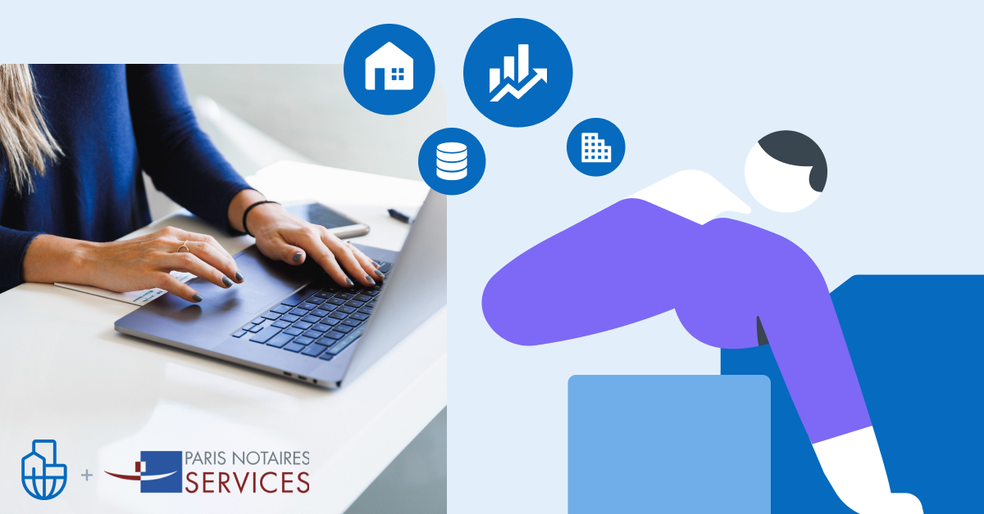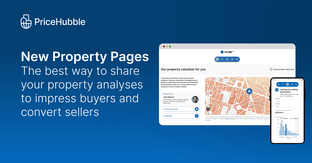The content of this article is partially based on our French webinar of 17 June 2021, jointly moderated by Frédérique Thollon-Baras and Sonia Labeth, Director of Real Estate Activities and responsible for the BIEN database at Paris Notaires Services, and Loeiz Bourdic, Director of PriceHubble France. Please contact us if you wish to view it.
Notaries are one of the essential links in the real estate chain. They are at the key point between the seller, the buyer and the agent. It is therefore not surprising to see many innovations in this field. One of the drivers of the transformation in this sector is undoubtedly the use of artificial intelligence, which has enabled great advances in the field of real estate valuation.
Real estate professionals must keep abreast of prices in their area as regularly and efficiently as possible. Many stakeholders in the real estate world (agents, experts, notaries, investors, portfolio managers, etc.) face this challenge, which is often complex to overcome.
In-depth knowledge of the real estate market – a major challenge
The accurate valuation of a property requires a great deal of data collection and market monitoring, a process that is often very time-consuming. It involves careful and rigorous monitoring, but also a detailed analysis of comparable properties as the value of a property is fundamentally linked to the value of similar properties. Frédérique Thollon-Baras, Director of Real Estate Activities for Paris Notaires Services (PNS) agrees: “In the real estate sector, we always want to find comparable properties. We like having a property that is equivalent to the one we have to sell, market or buy.”
It is important to take a considerable number of vairables to make an accurate value assessment. However, it is sometimes difficult to provide an accurate assessment, because the information is so complex and difficult to correlate.
To further complicate things, this issue arises in a health-related context that has led to greater volatility in real estate market prices in recent months. Some large cities, such as Paris, have seen a significant slowdown in price increases, and even a slight fall in real estate prices between 2020 and 2021. On the other hand, some markets, particularly for houses, have seen accelerated growth.
Two primary use cases can be identified for which real estate professionals need accurate real estate data and valuation tools:
- Advising individuals on their real estate purchases or sales in the best possible way.
- Making the best real estate decisions when acquiring, disposing of, or managing properties. This is true of professionals who own real estate or advise others on their real estate strategy: portfolio managers, landlords, investors, consultants and experts. For the latter, the challenge is to precisely analyse the value of a property in its market, on sometimes very large estates.
Speaking about the second use case, Loeiz Bourdic, Director of PriceHubble France, mentions an increase in the professionalisation of the stakeholders, which goes hand in hand with the development of new real estate analysis tools.
In short, whether they need to approach the “right” selling price in order to advise prospects and clients or to analyse a real estate portfolio in detail, professionals must be able to rely on the most up-to-date and accurate data. This raises the following question: What are the most commonly used valuation methods?
Which solutions are there for real estate valuation and monitoring of real estate market dynamics?
To assist them in their real estate valuations and in monitoring market dynamics, French real estate professionals have access to various databases on real estate transactions:
- The DVF database: The database of land value applications (DVF) was released by Decree No. 2018-1350 of 28 December 2018 and covers the land values declared at the time of real estate transfers. It is available free of charge in open data and gives information on post-2016 transactions in France. However, it has one major problem: the data are not reprocessed and are not subject to human review. These data are also incomplete, as some aspects that play a major role in the definition of the selling price, such as the condition of the property, the number of rooms, the floor of the dwelling or any additional space (balcony and terrace), are not mentioned.
- The BIEN database: Developed by PNS, thanks to the notaries of Île-de-France, the BIEN database is an extremely comprehensive database whose data is processed and verified. It contains over 4.3 million references, with up to 120 variables per reference. As Frédérique Thollon-Baras points out, “it is based on authenticated deeds signed at notaries’ offices, and as such represents very high quality data”. The website www.basebien.fr provides detailed information via a search for references, aggregated data and updated prices through dedicated modules.
There are also other solutions available that can be used to access real estate transaction data. However, they do not necessarily meet the specific requirements of French real estate experts, who want to be able to visualise the exact price of a property at any given moment with just a few clicks.
Fortunately, thanks to the ongoing digitalisation and transformation of the real estate sector, new solutions are emerging.
PNS/PriceHubble partnership for developing an AVM
The AVM (Automated Valuation Model) developed by Paris Notaires Services in partnership with PriceHubble is an excellent example of the dynamic innovation that has taken place in the sector in recent years. The Machine Learning algorithm, developed by PriceHubble, integrates the data from the BIEN database used by Paris Notaires Services, and now allows any professional to accurately assess the price of a real estate online.
In order to meet emerging requirements, PNS has called upon the expertise and technology of PriceHubble to develop this new algorithm. Frédérique Thollon-Baras explains that “a combination of favourable factors such as new requirements, the BIEN database, the improvement of AI technology and the expertise of PriceHubble enabled us to set up this project that addresses the problems of the different stakeholders involved in a transaction”. The aim of this solution is to expand the range of analysis tools that Paris Notaires Services offers to real estate professionals.
An R&D project involving various real estate stakeholders
PNS and PriceHubble wanted to set up a reliable, accurate, and above all “comprehensible” solution, as Loeiz Bourdic explained in the webinar: “What we mean by comprehensible AI is the ability to keep control of and explain the mechanisms within the algorithm, and thus understand the impact that each property characteristic (floor, year of construction, balcony, etc.) has on the price.”
It took just over six months of research and development to develop this valuation model. This process brought together the PNS and PriceHubble teams, but also more broadly the stakeholders among the real estate industry. Notaries and negotiators, economists, statisticians and real estate experts have also contributed to the improvement of this tool, by providing their professional know-how and market insights.
“This phase involved notaries with a series of workshops to improve the performance of the valuation algorithm using data from the BIEN database,” says Loeiz Bourdic.
This collaboration between the expertise of real estate professionals and AI specialists has made it possible to draw the best from both worlds, and to offer an accurate and efficient valuation solution.
During this stage of development, the first step was to integrate the data from the BIEN database, to supplement it with additional data, and then to adapt the PriceHubble valuation algorithms to the characteristics and granularity of the BIEN database.
This valuation tool comes with a confidence index, which indicates the level of accuracy of the assessment. Accuracy depends on several elements: the density of comparable transactions in the area, the similarity between the characteristics of the assessed property and those of comparable properties in the area (is it a standard property or an exceptional property?), and finally the volatility of comparable properties in the area.
The valuation is therefore more accurate for a Haussmann flat in Paris proper than for a house in the outer suburbs, where transactions are more limited and properties more heterogeneous.
A solution that is not meant to replace experts
The AVM project will instantly provide any professional client of the BIEN database with a price assessment for any old Île-de-France property. However, it is important to remember that this AVM is not meant to replace the expertise of real estate professionals. Visiting the property and seeing it for themselves is still a critical factor. Instead, it helps in the decision-making process and is a powerful and rapid tool for professionals in this sector, who are the real experts, the only ones able to determine and, above all, appraise the value of a property according to its detailed characteristics, within the framework of the various valuation standards. This tool is intended to enhance the range of tools available to them to analyse a property, while taking into account the reality of the real estate market.
The AVM tool is available free of charge as a beta version for all notaries and real estate professionals and users of the BIEN database. A feedback phase is still under way. So please do not hesitate to share your views on this tool with PNS.






